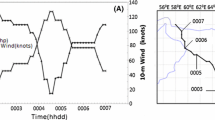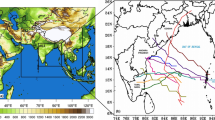Abstract
In this study, real-time predictions of the cyclone Nilam in the Bay of Bengal during October 27, 2012–November 01, 2012, using ARW mesoscale model are presented. The model is run with two nested domains (27 km × 9 km resolution) using the NCEP GFS 0.5° × 0.5° analysis and three hourly forecasts. A series of simulations with different initial conditions varying from 00UTC28Oct to 12UTC30Oct indicated that the prediction errors in respect of the vector track position and intensity are reduced with initial conditions corresponding to 12UTC29Oct. The error reduction is attributed to the better representation of cyclone vortex in the initial conditions corresponding to depression stage. Further experiments with the use of three-dimensional variational data assimilation (3D-Var) and Ocean Mixed Layer Model (OML) and comparison with a control run (CTRL_RUN) indicated that the 3D-Var and OML experiments improved the track and intensity predictions. While the 3D-Var experiment well predicted the overall track with lesser along-track errors, the OML experiment predicted more accurate landfall with an error of 55 km in landfall position and 5 h in landfall time. All the experiments simulated early landfall. It has been found that intensity of simulated cyclone is highest with CTRL_RUN followed by OML and 3D-Var experiments. While OML simulated a stronger cyclone for a brief period, the 3D-Var simulated a less intensive cyclone for a prolonged period in better agreement with IMD estimates. The improvements in track and intensity prediction using 3D-Var and OML are attributed to the improvements in initial conditions with observation assimilation in the former and to better representation of air–sea interaction (fluxes) in the latter. The overall better performance of the 3D-Var experiment is evident from the comparisons of flow-field, rainfall and maximum reflectivity parameters.

















Similar content being viewed by others
References
Asnani GC (2005) Tropical meteorology. Indian Inst. of Tropical Meteorology, Pune
Barker DM, Huang W, Guo YR, Xiao QN (2004) A three-dimensional (3D-Var) data assimilation system for use with MM5: implementation and initial results. Mon Weather Rev 132:897–914
Bhaskar Rao DV, Hari Prasad D (2006a) Sensitivity of tropical cyclone intensification to boundary layer and convective processes. Nat Hazards 41:429–445. doi:10.1007/s11069-006-9052-7
Bhaskar Rao DV, Hari Prasad D (2006b) Numerical prediction of the Orissa super cyclone (1999): sensitivity to the parameterization of convection, boundary layer and explicit moisture processes. Mausam 57:61–78
Bhaskar Rao DV, Hari Prasad D, Srinivas D (2009) Impact of horizontal resolution and the advantages of the nested domains approach in the prediction of tropical cyclone intensification and movement. J Geophy Res 114:D11106. doi:10.1029/2008JD011623
Bhaskar Rao DV, Hariprasad D, Srinivas D (2010) Role of vertical resolution in numerical models towards the intensification, structure and track of tropical cyclones. Mar Geodesy 33(4):338–355. doi:10.1080/01490419.2010.518066
Braun SA, Tao WK (2000) Sensitivity of high-resolution simulations of hurricane Bob (1991) to planetary boundary layer parameterizations. Mon Weather Rev 128:3941–3961
Davis CA, Bosart LF (2001) Numerical simulations of the genesis of hurricane Diana (1984). Part I: control simulation. Mon Weather Rev 129:1859–1881
Davis CA, Wang W, Chen SS, Chen Y, Corbosiero K, DeMaria M, Dudhia J, Holland G, Klemp J, Michalakes J, Reeves H, Rotunno R, Snyder C, Xiao Q (2008) Prediction of landfalling hurricanes with the advanced hurricane WRF model. Mon Weather Rev 136:1990–2005
Dudhia J (1989) Numerical study of convection observed during winter monsoon experiment using a mesoscale two-dimensional model. J Atmos Sci 46:3077–3107
Gentry MS, Lackmann GM (2010) Sensitivity of simulated tropical cyclone structure and intensity to horizontal resolution. Mon Weather Rev 138:688–704. doi:10.1175/2009MWR2976.1
Gopalakrishnan SG, Goldenberg S, Quirino T, Zhang X, Marks F, Yeh KS, Atlas R, Tallapragada V (2012) Toward improving high-resolution numerical hurricane forecasting: influence of model horizontal grid resolution, initialization, and physics. Weather Forecast 27:647–666
Hong SY, Lim JOJ (2006) The WRF single-moment 6-class microphysics scheme (WSM6). J Korean Meteorol Soc 42:129–151
Hong SY, Noh Y, Dhudia J (2006) A New vertical diffusion package with an explicit treatment of entrainment processes. Mon Weather Rev 134:2318–2341
Ide K, Courtier P, Ghil M, Lorenc AC (1997) Unified notation for data assimilation: operational, sequential and variational. J Metrol Soc Jpn 75:181–189
India Meteorological Department (2012) A preliminary report on cyclonic storm, NILAM over Bay of Bengal (28 Oct–01 Nov, 2012). Cyclone Warning Division, New Delhi
Jiang X, Zhong Z, Liu C (2008) The effect of Typhoon-induced SST cooling on Typhoon intensity: the case of Typhoon Chanchu (2006). Adv Atmos Sci 25(6):1062–1072
Kain JS (2004) The Kain–Fritsch convective parameterization: an update. J Appl Meteorol 43:170–181
Keyser D (2010) PREPBUFR processing at NCEP. http://www.emc.ncep.noaa.gov/mmb/data_processing/prepbufr.doc/document.htm
Knaff JA, DeMaria M, Molenar DA, Sampson CR, Seybold MG (2011) An automated objective, multiple-satellite-platform tropical cyclone surface wind analysis. J Appl Meteorol Climatol 50:2149–2166
Krishna KO, Routray A, Mohanty UC, Kulkarni MA (2010) Simulation of tropical cyclones over Indian Seas: data impact study using WRF-Var assimilation system. In: Charabi Y (ed) Indian ocean tropical cyclones and climate change. Springer, Netherlands, pp 115–124 10.1007/978-90-481-3109-9_15
Lin YL, Farley RD, Orville HD (1983) Bulk parameterization of the snow field in a cloud model. J Clim Appl Meteorol 22:1065–1092
Liu ZQ, Barker DM (2006) Radiance assimilation in WRF‐Var: implementation and initial results. In: Paper presented at 7th WRF Users’Workshop, NCAR, Boulder, Colo. http://www.mmm.ucar.edu/wrf/users/workshops/WS2006/abstracts/Session04/4_2_Liu.pdf
Mohanty UC, Osuri Krishna K, Routray A, Mohapatra M, Pattanayak S (2010) Simulation of Bay of Bengal tropical cyclones with WRF model: impact of initial and boundary condition. Mar Geodesy 33:294–314
Mukhopadhyay P, Taraphdar S, Goswami BN (2011) Influence of moist processes on track and intensity forecast of cyclones over the North Indian Ocean. J Geophys Res 116(D05):116. doi:10.1029/2010JD014700
Parrish DF, Derber JC (1992) The National Meteorological Center’s spectral statistical interpolation analysis system. Mon Weather Rev 120:1747–1763
Pattanaik S, Mohanty UC (2008) A comparative study on performance of MM5 and WRF models in simulation of tropical cyclones over Indian seas. Curr Sci 95(7):923–936
Pattanaik S, Mohanty UC (2010) Simulation of track and intensity of Gonu and Sidr with WRF-NMM modeling system. In: Charabi Y (ed) Indian ocean tropical cyclones and climate change. Springer, Berlin, pp 83–92
Pattanaik DR, Rama Rao YV (2009) Track prediction of very severe cyclone ‘Nargis’ using high resolution weather research forecasting (WRF) model. J Earth Syst Sci 118(4):309–329
Pollard RT, Rhines PB, Thompson RY (1973) The deepening of the wind-mixed layer. Geophys Fluid Dyn 3:381–404
Raghavan S, SenSarma AK (2000) Tropical cyclone impacts in India and neighbourhood. In: Pielke R Jr, Pielke R Sr (eds) Storms, vol 1. Routledge, London, pp 339–356
Raju PVS, Jayaraman P, Mohanty UC (2011a) Sensitivity of physical parameterizations on prediction of tropical cyclone Nargis over the Bay of Bengal using WRF model. Meteorol Atmos Phys 113(3–4):125–137. doi:10.1007/s00703-011-0151-y
Raju PVS, Jayaraman P, Mohanty UC (2011b) Prediction of severe tropical cyclones over the Bay of Bengal during 2007–2010 using high-resolution mesoscale model. Nat Hazards. doi:10.1007/s11069-011-9918-1
Rogers R, Chen S, Tenerelli J, Willoughby H (2003) A numerical study of the impact of vertical shear on the distribution of rainfall in Hurricane Bonnie (1998). Mon Weather Rev 131:1577–1599
Singh R, Pal PK, Kishtawal CM, Joshi PC (2008a) The impact of variational assimilation of SSM/I and QuikSCAT Satellite observations on the numerical simulation of Indian Ocean tropical cyclones (2008). Weather Forecast 23:460–476
Singh R, Pal PK, Kishtawal CM, Joshi PC (2008b) Impact of atmospheric infrared sounder data on the numerical simulation of Mumbai historical rain event. Weather Forecast 23:892–913
Singh R, Kishtawal CM, Pal PK, Joshi PC (2011) Assimilation of the multisatellite data into the WRF model for track and intensity simulation of the Indian Ocean tropical cyclones. Meteorol Atmos Phys 111(3–4):103–119. doi:10.1007/s00703-011-0127-y
Singh R, Kishtawal CM, Pal PK, Joshi PC (2012) Improved tropical cyclone forecasts over north Indian Ocean with direct assimilation of AMSU-A radiances. Meteorol Atmos Phys 115(1–2):15–34. doi:10.1007/s00703-011-0165-5
Skamarock WC, Klemp JB, Dudhia J, Gill David O, Barker DM, Dudha MG, Huang X, Wang W, Powers Y (2008) A description of the advanced research WRF Ver.30.NCAR Technical Note. NCAR/TN-475 + STR. Mesocale and microscale meteorology division, National Centre for Atmospheric Research, Boulder Colorado, USA, p 113
Srinivas CV, Yesubabu V, Venkatesan R, Ramakrishna SSVS (2010) Impact of assimilation of conventional and satellite meteorological observations on the numerical simulation of a Bay of Bengal tropical cyclone of Nov 2008 near Tamilnadu using WRF model. Meteorol Atmos Phys 110:19–44. doi:10.1007/s00703-010-0102-z
Srinivas CV, BhaskarRao DV, Yesubabu V, Baskaran R, Venkatraman B (2013a) Tropical cyclone predictions over the Bay of Bengal using the high-resolution advanced research weather research and forecasting model. Q J R Meteorol Soc. doi:10.1002/qj.2064
Srinivas CV, Yesubabu V, Hariprasad KBRR, Ramakrishna SSVS, Venkatraman B (2013b) Real-time prediction of a severe cyclone ‘Jal’ over Bay of Bengal using a high-resolution mesoscale model WRF (ARW). Nat Hazards 65:331–357. doi:10.1007/s11069-012-0364-5
World Meteorological Organization (2011) Tropical cyclone operational plan for the Bay of Bengal and Arabian Sea, World Meteorological Organization Tech. Tropical Cyclone Programme Rep. TCP-21, WMO/TD-84, 97 pp. World Meteorological Organization, Case Postale No. 5, HC-1211, Geneva 20, Switzerland. http://www.wmo.int/pages/prog/www/tcp/documents/TCP-21_2011final.pdf
Yang M, Ching L (2005) A modeling study of Typhoon Toraji 2001: physical parameterization sensitivity and topographic effect. Terr Atmos Ocean Sci 16:177–213
Zhang X, Quirino TS, Gopalakrishnan S, Yeh KS, Marks FD, Goldenberg SB (2011) HWRFX: improving hurricane forecasts with high resolution modeling. Comput Sci Eng 13:13–21
Zhu T, Zhang DL (2006) The impact of the storm induced SST cooling on hurricane intensity. Adv Atmos Sci 23(1):14–22
Zhu H, Ulrich W, Smith RK (2004) Ocean effects on tropical cyclone intensification and inner core asymmetries. J Atmos Sci 61:1245–1258
Acknowledgments
Authors sincerely thank Dr. S.A.V. Sathya Murthy, Director EIRSG, IGCAR for encouragement. The NCEP, USA is acknowledged for the public access of GFS products and observations for assimilation. IMD is acknowledged for the use of best-track and intensity estimates and the DWR reflectivity composites of tropical cyclones. Authors thank the anonymous reviewers for their highly technical review and useful suggestions that helped to improve the quality of the manuscript.
Author information
Authors and Affiliations
Corresponding author
Rights and permissions
About this article
Cite this article
Mohan, G.M., Srinivas, C.V., Naidu, C.V. et al. Real-time numerical simulation of tropical cyclone Nilam with WRF: experiments with different initial conditions, 3D-Var and Ocean Mixed Layer Model. Nat Hazards 77, 597–624 (2015). https://doi.org/10.1007/s11069-015-1611-3
Received:
Accepted:
Published:
Issue Date:
DOI: https://doi.org/10.1007/s11069-015-1611-3




